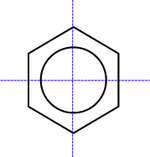Centrosymmetry

In crystallography, a point group which contains an inversion center as one of its symmetry elements is centrosymmetric.[1] In such a point group, for every point (x, y, z) in the unit cell there is an indistinguishable point (-x, -y, -z). Such point groups are also said to have inversion symmetry.[2] Point reflection is a similar term used in geometry. Crystals with an inversion center cannot display certain properties, such as the piezoelectric effect.
The following space groups have inversion symmetry: the triclinic space group 2, the monoclinic 10-15, the orthorhombic 47-74, the tetragonal 83-88 and 123-142, the trigonal 147, 148 and 162-167, the hexagonal 175, 176 and 191-194, the cubic 200-206 and 221-230.[3]
Point groups lacking an inversion center (non-centrosymmetric) are further divided into polar and chiral types. A chiral point group is one without any rotoinversion symmetry elements. Rotoinversion (also called an 'inversion axis') is rotation followed by inversion; for example, a mirror reflection corresponds to a twofold rotoinversion. Chiral point groups must therefore only contain (purely) rotational symmetry. These arise from the crystal point groups 1, 2, 3, 4, 6, 222, 422, 622, 32, 23, and 432. Chiral molecules such as proteins crystallize in chiral point groups.
The term polar is often used for those point groups which are neither centrosymmetric nor chiral. However, the term is more correctly used for any point group containing a unique anisotropic axis. These occur in crystal point groups 1, 2, 3, 4, 6, m, mm2, 3m, 4mm, and 6mm. Thus some chiral space groups are also polar.
See also
References
- ↑ Tilley, Richard (2006). "4". Crystals and Crystal Structures. John Wiley. pp. 80–83. ISBN 978-0-470-01821-7.
- ↑ Fu, Liang; Kane, C. "Topological insulators with inversion symmetry". Physical Review B 76 (4). doi:10.1103/PhysRevB.76.045302.
- ↑ Cockcroft, Jeremy Karl. "The 230 3-Dimensional Space Groups". Birkbeck College, University of London. Retrieved 18 August 2014.